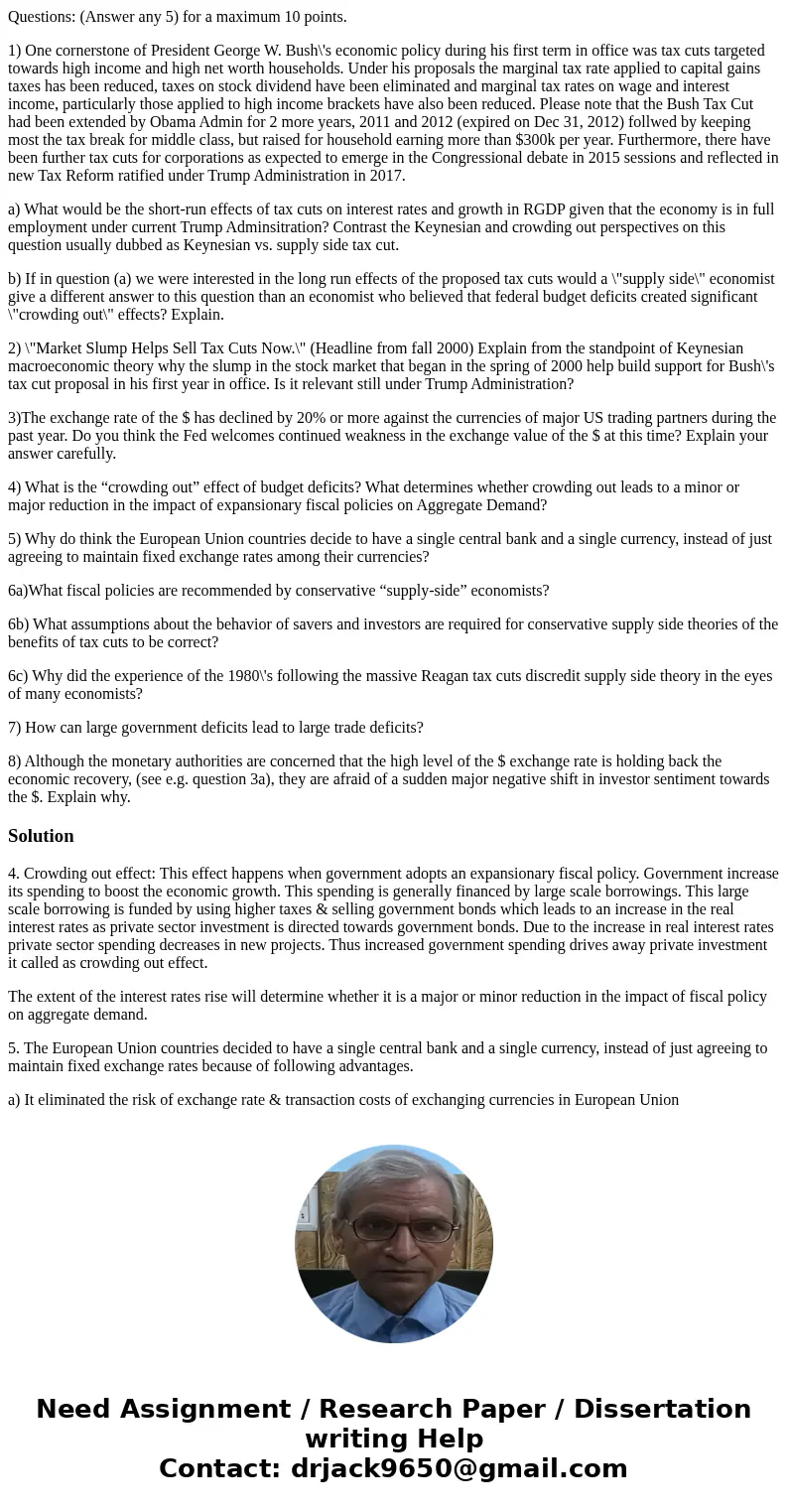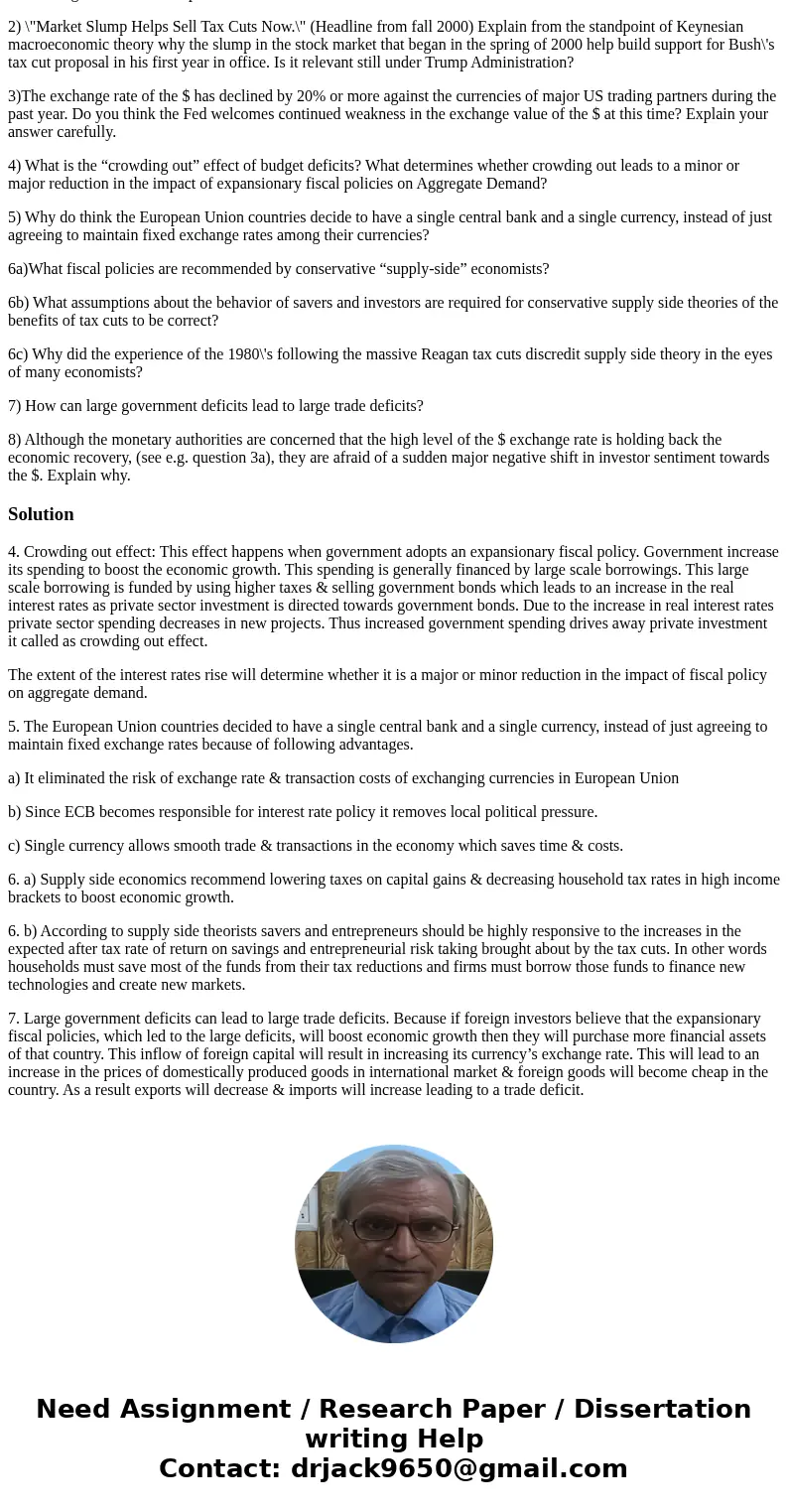Questions Answer any 5 for a maximum 10 points 1 One corners
Questions: (Answer any 5) for a maximum 10 points.
1) One cornerstone of President George W. Bush\'s economic policy during his first term in office was tax cuts targeted towards high income and high net worth households. Under his proposals the marginal tax rate applied to capital gains taxes has been reduced, taxes on stock dividend have been eliminated and marginal tax rates on wage and interest income, particularly those applied to high income brackets have also been reduced. Please note that the Bush Tax Cut had been extended by Obama Admin for 2 more years, 2011 and 2012 (expired on Dec 31, 2012) follwed by keeping most the tax break for middle class, but raised for household earning more than $300k per year. Furthermore, there have been further tax cuts for corporations as expected to emerge in the Congressional debate in 2015 sessions and reflected in new Tax Reform ratified under Trump Administration in 2017.
a) What would be the short-run effects of tax cuts on interest rates and growth in RGDP given that the economy is in full employment under current Trump Adminsitration? Contrast the Keynesian and crowding out perspectives on this question usually dubbed as Keynesian vs. supply side tax cut.
b) If in question (a) we were interested in the long run effects of the proposed tax cuts would a \"supply side\" economist give a different answer to this question than an economist who believed that federal budget deficits created significant \"crowding out\" effects? Explain.
2) \"Market Slump Helps Sell Tax Cuts Now.\" (Headline from fall 2000) Explain from the standpoint of Keynesian macroeconomic theory why the slump in the stock market that began in the spring of 2000 help build support for Bush\'s tax cut proposal in his first year in office. Is it relevant still under Trump Administration?
3)The exchange rate of the $ has declined by 20% or more against the currencies of major US trading partners during the past year. Do you think the Fed welcomes continued weakness in the exchange value of the $ at this time? Explain your answer carefully.
4) What is the “crowding out” effect of budget deficits? What determines whether crowding out leads to a minor or major reduction in the impact of expansionary fiscal policies on Aggregate Demand?
5) Why do think the European Union countries decide to have a single central bank and a single currency, instead of just agreeing to maintain fixed exchange rates among their currencies?
6a)What fiscal policies are recommended by conservative “supply-side” economists?
6b) What assumptions about the behavior of savers and investors are required for conservative supply side theories of the benefits of tax cuts to be correct?
6c) Why did the experience of the 1980\'s following the massive Reagan tax cuts discredit supply side theory in the eyes of many economists?
7) How can large government deficits lead to large trade deficits?
8) Although the monetary authorities are concerned that the high level of the $ exchange rate is holding back the economic recovery, (see e.g. question 3a), they are afraid of a sudden major negative shift in investor sentiment towards the $. Explain why.
Solution
4. Crowding out effect: This effect happens when government adopts an expansionary fiscal policy. Government increase its spending to boost the economic growth. This spending is generally financed by large scale borrowings. This large scale borrowing is funded by using higher taxes & selling government bonds which leads to an increase in the real interest rates as private sector investment is directed towards government bonds. Due to the increase in real interest rates private sector spending decreases in new projects. Thus increased government spending drives away private investment it called as crowding out effect.
The extent of the interest rates rise will determine whether it is a major or minor reduction in the impact of fiscal policy on aggregate demand.
5. The European Union countries decided to have a single central bank and a single currency, instead of just agreeing to maintain fixed exchange rates because of following advantages.
a) It eliminated the risk of exchange rate & transaction costs of exchanging currencies in European Union
b) Since ECB becomes responsible for interest rate policy it removes local political pressure.
c) Single currency allows smooth trade & transactions in the economy which saves time & costs.
6. a) Supply side economics recommend lowering taxes on capital gains & decreasing household tax rates in high income brackets to boost economic growth.
6. b) According to supply side theorists savers and entrepreneurs should be highly responsive to the increases in the expected after tax rate of return on savings and entrepreneurial risk taking brought about by the tax cuts. In other words households must save most of the funds from their tax reductions and firms must borrow those funds to finance new technologies and create new markets.
7. Large government deficits can lead to large trade deficits. Because if foreign investors believe that the expansionary fiscal policies, which led to the large deficits, will boost economic growth then they will purchase more financial assets of that country. This inflow of foreign capital will result in increasing its currency’s exchange rate. This will lead to an increase in the prices of domestically produced goods in international market & foreign goods will become cheap in the country. As a result exports will decrease & imports will increase leading to a trade deficit.


 Homework Sourse
Homework Sourse